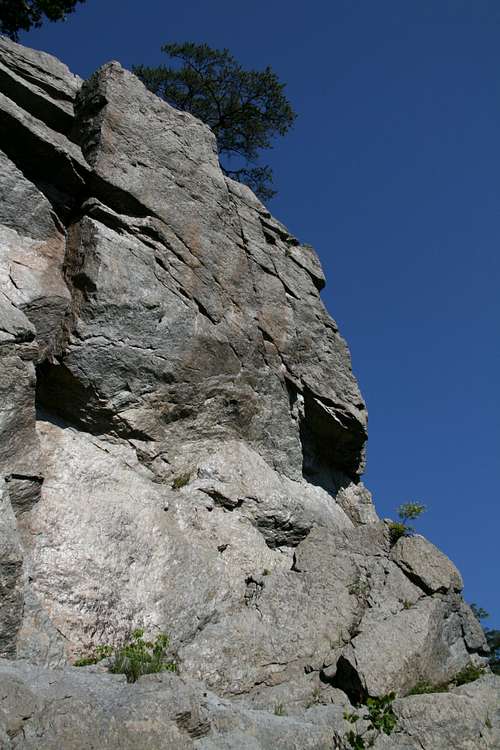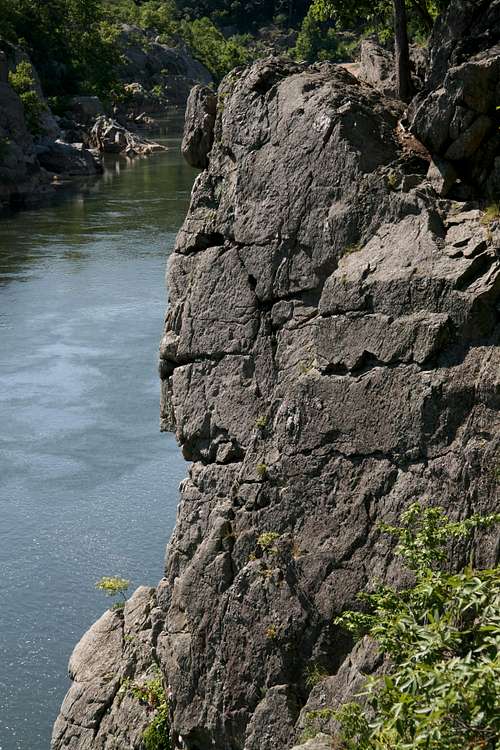-
 8586 Hits
8586 Hits
-
 79.04% Score
79.04% Score
-
 10 Votes
10 Votes
|
|
Mountain/Rock |
|---|---|
|
|
38.98770°N / 77.2475°W |
|
|
Trad Climbing, Toprope |
|
|
Spring, Summer, Fall, Winter |
|
|
157 ft / 48 m |
|
|
Overview
Cornice is downstream of the most popular climbing crags at Great Falls and thus sees less traffic, but that’s no guarantee you’ll have it to yourself on any given day. The climbs are on typically solid Great Falls schist and range from 45 to 60 feet. The routes on the crag are better-suited for advanced climbers, as the majority are 5.10 or 5.11. There are, though, a 5.6 and two 5.7’s, and there is a 5.1. I like to free solo, but I also like to play it reasonably safe, and that 5.1 is the only named route here suitable for the average unroped climber.
Almost all climbers at Great Falls toprope the routes because it is convenient, there are usually plenty of natural anchors, and the rock has been known to be unfriendly to placing protection (the pro has been known to slide out of place on the very smooth rock that characterizes much of the area). But people do lead with natural gear, and there are a few crack routes at Cornice that might be nice to nuts and cams.
The named routes here, from the upstream to the downstream end (most of them are entirely or partially visible in this page’s photos and have some descriptive information with them):
•The Nose (5.6)-- Good potential for leading; fun route with very thrilling exposure.
•Crank Up (5.10)
•Cranko (5.10)
•Tiparillo (5.11)
•Cornice (5.7+)—One guidebook describes this as being perhaps the best moderate climb in the Potomac River Gorge. Definitely a classic.
•Little Devil (5.10)
•Lawrence’s Last (5.1)—I climbed this route unroped. It feels harder than 5.1, maybe 5.2 or 5.3, right around the middle. You find yourself in a very tight corner causing you to move from very awkward positions. Once through that spot, you’ll likely find the rest is quite easy. It’s still Class 5, but more like 5.0.
•Darius Green’s Flying Machine (5.10)
•First Blood (5.10)
•Conroy Wasn’t Here (5.7)-- Easy if you're tall.
Getting There
From the western part of I-495, a piece of the Capital Beltway, take Exit 44 for Route 193, Georgetown Pike; this is the second exit south of the Maryland border. Drive west for a few miles until you see the well-signed road leading to Great Falls Park. Turn right and follow the road about a mile to the entrance station. Enter and take an immediate right to reach a large parking area used by most climbers and boaters here.To reach the crag, hike east to the River Trail, and go right. After passing the Sandbox and Dihedrals access points (there are signs indicating them), the trail drops down some wooden steps, makes a bridged stream crossing, and then climbs a set of wooden steps. At the top of the climb, the trail splits in three, with the River Trail heading right. Follow the River Trail across some wooden planks, and stay on it as it bends away from the river and passes an old canal. Shortly after the canal, you return to the clifftops. The first ones are the top of the Bird's Nest crag. The next ones are those at Cornice. Look for the rock face pictured in this section, and then hike past it to find a ledge system that descends to the river. If you find the easiest way down, you'll be looking at Class 3. Watch out for the poison ivy.
It should take around 20 minutes to hike from the parking area to the top of Cornice.
Red Tape
The park is open from 7 A.M. until dark every day except Christmas. There is an admission fee, good for three days, of $5 per vehicle or $3 per person entering on foot or by bicycle. Annual and interagency passes are also available (the latter costs $80).Climbers are required to register (free). There is a registration box at the climbers’ parking area, and there is also one at the visitor center.
Drilling to place bolts is prohibited.
The area is popular and can be quite crowded, especially on weekends spring through fall. Also, some of the people there, skilled as they may be, are less the sanctity-of-nature types and more the types who see mountains and crags as a climbing gym with cool views. If you like quieter climbing, try going on a weekday or in winter.
The park is home to copperheads. It’s unlikely that they hang out in holds on the cliffs themselves, but be aware. The danger, though slim, is greatest near the clifftops, where there are more places for snakes to be.
Poison ivy is abundant, especially along the descent route. The humid period from late spring through early fall features gnats, mosquitoes, and other biting insects.
Camping
NoneExternal Links
Great Falls NPS siteA good resource for the area is Eric Horst’s Rock Climbing Virginia, West Virginia, and Maryland. The section on Great Falls provides one-sentence overviews of the routes. There are also photos, taken either from a boat or from the Maryland side, of the crags, and the photos have useful diagrams showing the locations and directions of the routes. The guide leaves the step-by-step concerns, and the fun, to you.
An even better resource is the PATC Climbers' Guide, which focuses just on the Great Falls area. It lists more crags and routes than the other guide does, and the photos are usually better in terms of helpfulness with finding the routes.




